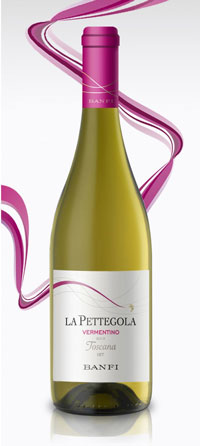There were many surprises at the Best in Glass Wine Challenge last month, among them the number of wines our sommelier-judges voted gold medals and the geographic range of the medal-winning wines – for details see my blog post from May 25.
Another element I touched on in the blog post and want to expand on here are the wineries that had multiple gold medal wines. Two wineries garnered four gold medals each at BIG and they are an interesting contrast. Castello Banfi is a large and well-known American-owned winery in Italy making more than 11 million bottles of wine each year at its several properties embracing more than 7,000 acres of vineyards (as a point of reference, Manhattan island is just over 8,000 acres). The other four-medal winner, called Proemio, is a mid-sized winery making about 660,000 bottles, (or 55,000 cases annually) founded just 13 years ago in Mendoza, Argentina.
 La Pettegola Vermentino, a crisp and flavorful alternative to pinot grigio and sauvignon blanc [Photo: Castello Banfi]
La Pettegola Vermentino, a crisp and flavorful alternative to pinot grigio and sauvignon blanc [Photo: Castello Banfi] The four Banfi wines that won gold medals include two white wines (San Angelo Pinot Grigio and La Pettegola Vermentino, both from Tuscany) and two reds, a “super-Tuscan” blend called Belnero and a fruity red wine from Piedmont, L’Ardì Dolcetto. Of the four, the most interesting to me are the vermentino and the dolcetto, both made from grapes that are under-appreciated by the public but wonderful food wines (and thus perfect for the by-the-glass emphasis of Best in Glass). Vermentino makes a crisp, fruity wine that has more personality than most pinot grigios and is not as pungently aromatic as many New World sauvignon blancs. If you like either pinot grigio or sauvignon blanc, Banfi’s vermentino is definitely worth a try – it is reasonably priced (just under $20), makes a splendid aperitif and with, its crisp freshness, goes very well with many foods.
From its name, you might at first think the dolcetto grape makes a sweet wine (dolce is Italian for sweet) but it invariably produces a medium bodied, fruity and dry red wine that is the very essence of charm in a glass. In fact, quite the opposite of being sweet, there is sometimes a very slight bitterness that accents the grape’s fruitiness and the wines seldom are aged in oak, so they have mild tannins and can be drunk fairly young. This, of course, is the perfect recipe for a wine you would want by the glass, perhaps as an aperitif or with a light first course, before you pull out a bottle of a heavier red for the main course.
 L’Ardì Dolcetto, a dry and fruity red from Italy’s Piedmont [Photo: Castello Banfi]
L’Ardì Dolcetto, a dry and fruity red from Italy’s Piedmont [Photo: Castello Banfi] What I like most about dolcetto is its “drinkability.” It’s a wine for everyday enjoyment rather than wine for a special occasion (though any occasion with a bottle of dolcetto strikes me as pretty special anyway). I think what our judges liked most about the L’Ardì Dolcetto is the combination of quality and price – to get a bottle of elegant red wine for $14 is a good thing indeed. This dolcetto is one of those wines that’s good for a group dining out because it pairs well with so many foods, and of course, as our judges attest, it is lovely by the glass.
With the wines of proemio we are operating in a different sphere – a more unified style and a more focused range. That’s understandable because proemio (the name comes from the Medieval Spanish word for prelude) is a smaller property with a much smaller portfolio. What that portfolio clearly offers is a consistent level of quality and a consistently affordable price point. The winery’s focus is evident in the wines that won gold medals: two malbecs, one aged in oak and one aged without oak, a cabernet sauvignon and the Grand Reserve Winemaker’s Selection red blend. With prices for the malbecs and cabernet hovering around $10, our judges found these wines irresistible in blind tastings.

Proemio is a relatively new property, founded in 2003 by Marcelo Bocardo, a winemaker who began his career making bulk wine (inexpensive wine sold in large containers or to other wineries). He went on to create a thriving business exporting grape juice concentrate from Argentina to Japan and then used his business acumen to create a winery using some of bulk wine skills with higher quality fruit. The results certainly showed up in our blind tastings. With only a short period in oak (or no time at all for the unoaked malbec), the two malbecs and the cabernet have charming, youthful fruit while the winemaker’s reserve blend of malbec, cabernet sauvignon, merlot and syrah, with 18 months aging, shows a bit of mature complexity.
While each individual wine has its strengths, the fact these two properties each won four medals also illustrates an important point for us consumers: consistency. We can take this kind of showing as a confirmation of the brand as well as the individual bottles. Here, on the VeritageMiami website, we have all the gold and silver medal-winning wines listed so you can begin your own explorations.
